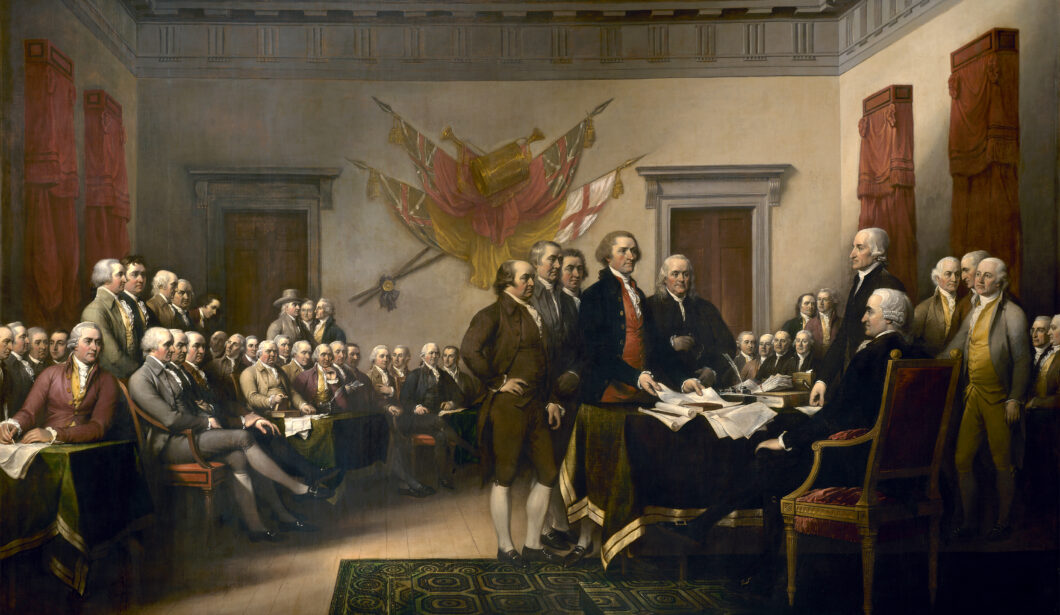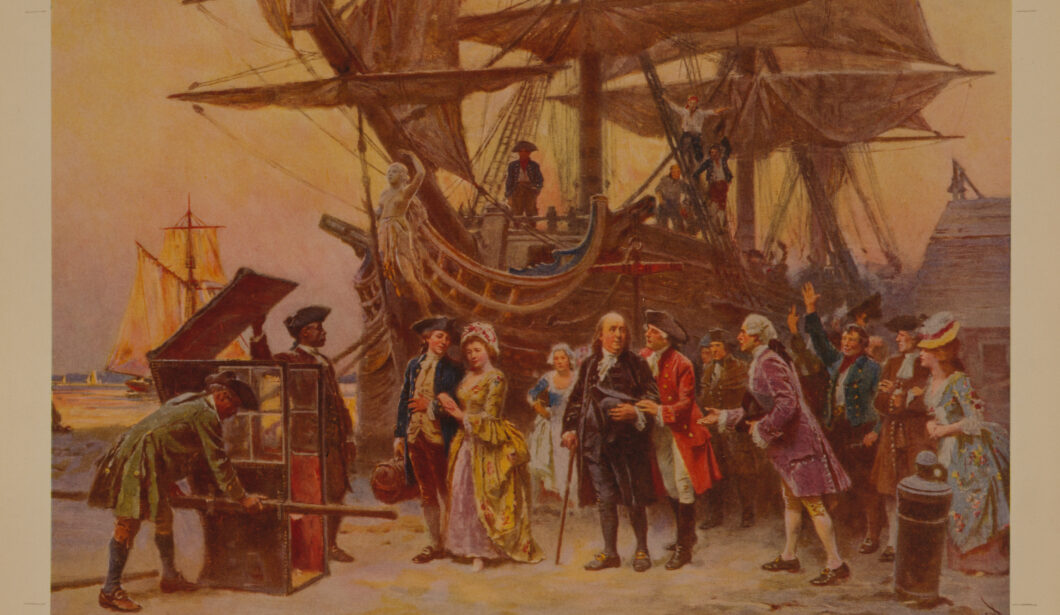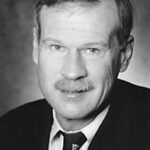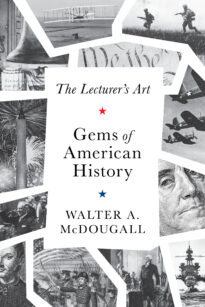The year 2026 will mark America’s 250th anniversary, and President Donald Trump has promised us a ‘spectacular birthday party.’ But behind the hoopla lurks a deadly serious question. What sentiments should the celebrants seek to rekindle in the hearts of the American people? Will the semiquincentennial anniversary of the Declaration of Independence turn out to be merely a more elaborate iteration of the parades-and-barbecues holiday, or may it be an occasion for Americans of whatever color, creed, or sex, to meditate on their nation’s miraculous founding? This article, one of a dozen in Pulitzer Prize-winning historian Walter McDougall’s Gems of American History, describes in loving detail the contexts and inspirations which led to the proclamation of the United States in America. For however much Thomas Jefferson’s invoked universal principles, the declaration by Congress was first and foremost a war measure.
—
The Second Continental Congress convened in Philadelphia in May 1775, a month after fighting broke out on Lexington Green. There was no assurance that the other colonies would permit the hot-headed New Englanders to drag them into treason and war. But a sea change had occurred in Philadelphia, where the formation of extra-legal committees to bypass the proprietor’s assembly had quickly become a habit. As one historian put it, Pennsylvania in spring 1774 was still governed by an oligarchy based on a restricted electorate, but in just two years turned into the most vibrant participatory democracy in the world. That radical, militant populism was the basis for the historian Carl Becker’s claim that the American revolution was not about “home rule, but about who would rule at home,” a claim later revived by the Marxist historian Gary Nash. But the important point was that Patriots in the congress were greatly encouraged by what was occurring in Philadelphia’s streets.
The populist movement climaxed in the formation of militia committees that made the willingness to bear arms the measure of patriotism, in defiance of Quakers, who still made up 15 percent of the city’s population. Thousands of militiamen marched, drilled, and in effect governed in defiance of the Assembly, psychologically preparing a critical mass of the populace for armed resistance.
There was no assurance that the other colonies would permit the hot-headed New Englanders to drag them into treason and war. But a sea change had occurred in Philadelphia, where the formation of extra-legal committees to bypass the proprietor’s assembly had quickly become a habit.
Accordingly, the Second Continental Congress began to function as an American government a year before it declared independence. On June 14, 1775, it founded the Continental Army and placed George Washington in command. John Adams was the wise head who nominated the “gentleman from Virginia,” thereby cementing an alliance between New England and the South. But it is hard to imagine his unanimous selection had Congress met anywhere else but on Philadelphia’s neutral ground. October 13, 1775, was the birthday of the United States Navy and November 10 that of the Marine Corps. Still, opinions were sharply divided over the prospect of independence, which the Pennsylvania delegates Dickinson, his legal protégé Wilson, and the businessman Morris considered risky and at best premature. So Congress decided to send an “Olive Branch Petition” to the King even as it approved a plan to invade Canada thirteen months before the Declaration of Independence.
Finally, in November 1775, another sojourner (who had sailed for America on the advice of Franklin) wrote a pamphlet that was quickly printed and disseminated throughout all thirteen colonies. Tom Paine’s Common Sense evangelized Americans with a republican gospel, which in turn emboldened Virginia Congressman Richard Henry Lee to call the question on June 3, 1776. “Our enemies,” he cried, “are determined upon the absolute conquest and sub-duction of North America. It is not choice then but necessity that calls for Independence, as the only means by which foreign Alliances can be obtained; and a proper Confederation by which internal peace and union can be secured.” Eleven days later extra-legal militias surrounded the State House and goaded Pennsylvania’s assembly into “forming further compacts between the united colonies, concluding such treaties with foreign kingdoms and States, and in adopting such other measures as . . . shall be judged necessary for promoting the liberty, safety, and interests of America.”
Tom Paine’s Common Sense evangelized Americans with a republican gospel, which in turn emboldened Virginia Congressman Richard Henry Lee to call the question on June 3, 1776.
Lee’s motion was hotly debated until July 1, when it was brought to a vote. Nine colonies voted aye, but New York’s delegation, pleading no instructions, abstained; Delaware divided 1 to 1 because Patriot Caesar Rodney was absent; and South Carolina and Pennsylvania split narrowly against. The tension was electric because the British were on the verge of invading New York. Hundreds of sails had already been sighted off Long Island. Was this the best time to vote independence or the worst? If the Pennsylvania delegation continued to hang back, chances were Delaware, New Jersey, and New York would also balk and the edifice collapse for want of its keystone.
Then something happened which historians to this day cannot fully explain. When a second vote was called on July 2, Morris and Dickinson retreated “behind the bar” and sat with the gallery. That left Pennsylvania’s decision up to Franklin and John Morton, who were in favor of independence; Thomas Willing and Charles Humphreys, who were opposed; and Wilson, who reluctantly broke with his mentor Dickinson and cast the decisive vote for independence. He did so, he said, because the people of Philadelphia had made their will clear in the “recent dramatic events.” As for Morris, he explained that while he still hoped for negotiations he refused to break the unity on which the colonies’ leverage depended. Morris later signed the Declaration. Dickinson never did, even though he knew it would turn his popularity into calumny. “I have so much of the spirit of Martyrdom in me, that I have been conscientiously compelled to endure in my political Capacity the Fires & Faggots of persecution.”
New York still abstained, but when the Delaware and South Carolina delegations fell into line, Congress pronounced the Declaration unanimous. On July 3 Philadelphia’s militia committee chose its own slate of revolutionaries for Pennsylvania’s constitutional convention. On July 4 Congress approved Jefferson’s redacted draft. On July 6 crowds of Philadelphians tore the royal coat of arms from the State House façade.

The historians Carl and Jessica Bridenbaugh summed up the unique metamorphosis of the city. “Between 1760 and 1775 Philadelphia came of age and was now spiritually prepared to go its way alone. Silently and for the most part unconsciously, it had undergone an intellectual revolution; it had shaken off its early allegiance to Old World standards and conventions and had chosen for itself the democratic direction. . . . This process, effected in the short span of thirty-five years by hundreds of eager, able, intelligent Philadelphians, produced upon the banks of the Delaware a city owning the first broadly democratic society of modern times.”
To suggest the Philadelphia factor was equally indispensable to the outcome of the War of Independence would be a stretch. Even British occupation of the city in 1777–78 (during which Congress fled to York, Pennsylvania, and Washington’s army shivered at Valley Forge) had no strategic impact. But two Philadelphians, Franklin and Morris, played indispensable roles as chief diplomat and chief financier of the American cause.
David Hackett Fischer’s encyclopedic history Albion’s Seed describes the four cradle cultures that British colonists planted in North America: the Puritans of New England, the Quakers of the Delaware Valley, the Cavaliers of the Chesapeake, and the Scots-Irish Bordermen of the Allegheny frontier. Fischer imagined the War of Independence a sequence of conflicts fought by those four cradle cultures. Phase one was the Puritans’ War, waged by New England militias egged on by their Congregational clergy. Phase two was the Cavaliers’ War, in which regular armies led by gentlemen fought conventional battles. Phase three was the Bordermen’s War waged by bush-whacking artisans in the southern back-country. Phase four was, if not the Quakers’ war (which would have been a contradiction in terms), then a political struggle waged by civilians from the Middle Colonies.
In fact, all four phases occurred simultaneously, and success depended on all of them, not least the civilians’ war. For the most decisive event in the eight-year conflict occurred in late March 1778, when King Louis XVI of France received Franklin at Versailles and concluded a full-fledged military alliance with the United States. Thus did Franklin fulfill the principal purpose of the Declaration of Independence, which was to enable Congress to solicit foreign assistance. The Declaration was first and foremost a war measure.
...King Louis XVI of France received Franklin at Versailles and concluded a full-fledged military alliance with the United States. Thus did Franklin fulfill the principal purpose of the Declaration of Independence, which was to enable Congress to solicit foreign assistance. The Declaration was first and foremost a war measure.
As early as November 1775 Congress had named a Secret Committee of Correspondence to seek ties with foreign powers, and after the Fourth of July 1776 the committee persuaded the seventy-year-old Franklin to head the American delegation. While serving as the colony’s agent in London for twenty-odd years he had visited Paris on several occasions and was renowned there as a scientist, statesman, philosopher, and rustic wit: roles he reprised to perfection. Franklin’s experience had taught him the Machiavellian lesson that the sure way to fail in politics and diplomacy was to be forthright, direct, and impatient, whereas deception, indirection, and patience at least gave a chance of success. Congress knew none of that when it asked John Adams to draft the so-called Model Treaty of 1776, a simple pact of friendship and commerce, expecting that was enough to win foreign recognition. Franklin did not waste the time of Louis XVI’s Foreign Minister, Charles Gravier le Comte de Vergennes, with such expressions of American idealism. Instead, he wooed and tempted the French court while engaging in duplicitous correspondence designed to confound British spies. But most of all he waited for some battlefield victory that might persuade Vergennes the American cause was for real. The Battle of Saratoga did the trick, and on February 6, 1778, Bourbon France concluded a military alliance with the U.S. Congress and pledged to make war and peace together. In fact, the Americans got a bonus prize when Vergennes persuaded the Bourbon king of Spain to join the anti-British alliance.
How critical were those alliances to American victory? Suffice to say that Washington won the climactic 1781 battle of Yorktown thanks to an entirely French army commanded by Jean-Baptiste, le Duc de Rochambeau, a mostly American army commanded by Marie-Joseph, le Marquis de Lafayette, a French fleet commanded by François-Joseph le Comte de Grasse, and a campaign plan drafted by Francisco Saavedra de Sangronis, the Spanish governor in Havana!
To be sure, the French court hardly waged war out of sympathy for a revolutionary republic. It waged war to avenge its prior defeat at the hands of the British and perhaps to regain a foothold in the New World. What is more, Vergennes betrayed signs of wanting to make the United States a client state as well as restrict its territorial growth. That is why, when the British offered to talk peace after Yorktown, Franklin double-crossed Vergennes and negotiated separately with the British. John Jay and John Adams, whom Congress appointed to the peace delegation, were shocked and confused by Franklin’s duplicity. But they were happy to share the credit for the generous terms Franklin obtained in the Peace of Paris of September 3, 1783 (the real, international, birthday of the United States). “We were better diplomats than we imagined,” boasted Adams in retrospect.

What most textbooks do not tell you is that arms alone cannot win wars and that wars rarely pay for themselves. In 1781, the year Franco-American arms triumphed at Yorktown, Congress was broke and already $25 million in debt. But that was the moment Robert Morris placed his personal fortune at the disposal of the new nation. A grateful Congress broke its own habit of working through committees when it created an executive office for Morris, Superintendent of Finance, which he held for the duration.
Morris would later be accused of wielding dictatorial powers, lining his own pockets, and indulging in reckless speculations of the sort that would later land him in debtor’s prison. What he really displayed, however, was the American penchant for hustling and creative corruption in the public interest. More than anyone else he deserved the sobriquet “financier of the Revolution.”
Morris was raised in Liverpool, England, to age thirteen, at which point his father set up as a tobacco broker in Maryland. He sent young Robert to apprentice in Thomas Willing’s Philadelphia merchant house, where he became partner at the tender age of twenty. Having made a fortune in foreign trade he had been reluctant to support independence in 1776. But once that step was taken, he threw himself into the cause. “I am not one of those politicians that run testy when my own plans are not adopted,” he said. “I think it is the duty of a good citizen to follow when he cannot lead.”
During 1776 and 1777 Morris exhorted Philadelphia merchants to join him in the purchase of supplies for the Continental Army and issued “Morris notes” backed by his own money. In the new state assembly, he worked to establish checks and balances and to overturn religious tests for office that Presbyterians had been applying to exclude Quakers, Mennonites, and Jews. He also assisted Wilson in his legal defense of Haym Salomon, another patriotic financier accused of profiteering. His contributions climaxed in 1781 when he helped to underwrite Washington’s victorious Yorktown campaign. The British continued to hope that the war of bullets might turn into a war of bottom lines which the United States seemed likely to lose. But thanks to Morris’s Bank of North America Washington’s army staggered across the finish line.
Read more in Gems of American History: The Lecturer’s Art

